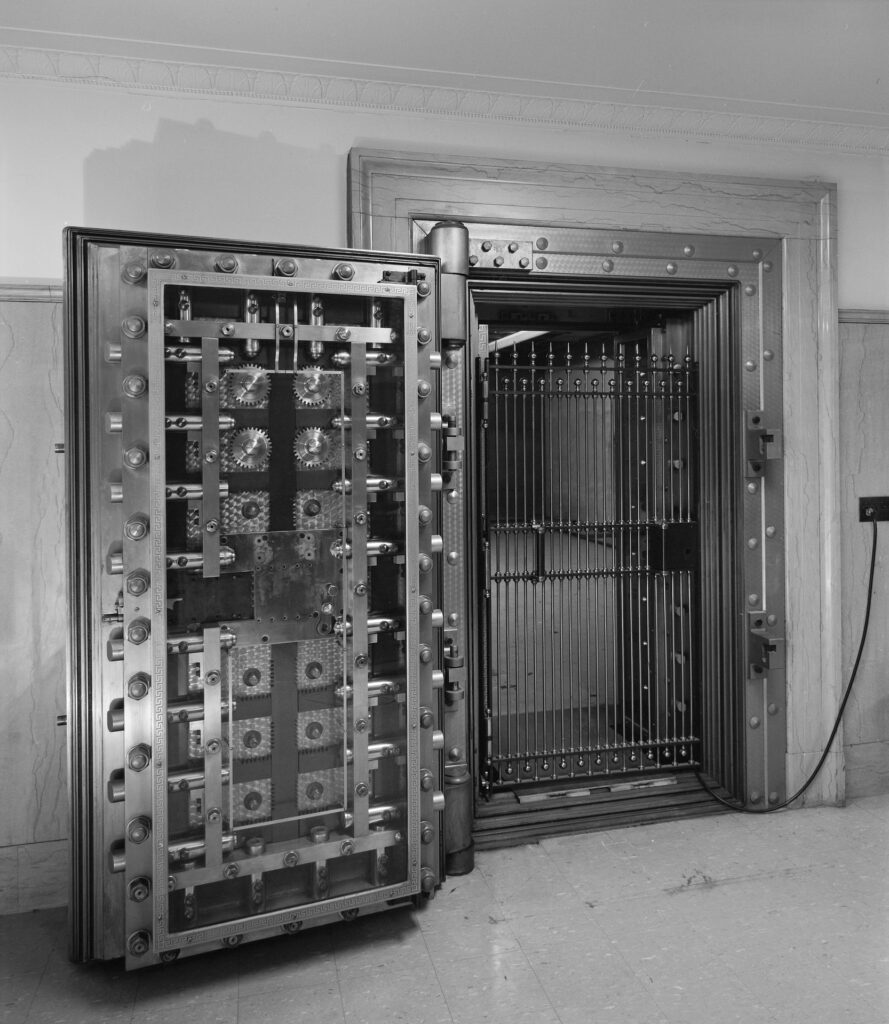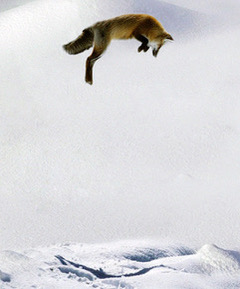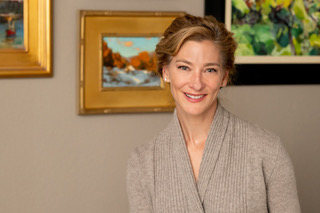
As we continue through 2020 in times of increased uncertainty, nonprofit organizations are taking a good look at their long-term sustainability when it comes to securing and increasing funding. With increased competition for both foundation and major donor funds during the COVID-19 pandemic, now more than ever we are seeing the real value of sustainable major giving programs.
That’s why in our latest resource, we’ll examine:
- Why major giving is so important
- What questions you should be asking at your organization before embarking on a Major Gifts program
- A sample program design and timeline for implementing a Major Gifts program
- How to recognize your major donors & recommendations for printed collateral
- A spotlight on a unique type of major giving: multi-year unrestricted funding
Recognizing that less-resourced NGOs can’t afford to engage our fundraising services, one of the ways Black Fox Philanthropy serves the social sector is to be open-source on much of the content we’ve developed. We regularly release this content via our blog, and today is another one of those days!
We strive to be as open-source as possible with the content we develop. As with our other blog posts, we enable a ‘plug and play’ approach with these resources, accessible to everyone, from the novice fundraiser to the most experienced. Please feel free to download a copy and use it to enhance your organization’s strategy.
1) Why is major giving so important?
The gold in launching a major gifts circle among individual funders is manifold. It deepens funder engagement through building community with the organization’s leadership and other mission-aligned funding partners; members ideally play a role as thought partners and ambassadors, introducing the organization to their networks; and in many cases, the program serves as a pipeline to a board role. The infrastructure also supports the ability to steward a larger number of partners in a meaningful way, creating more capacity to pursue and engage more funding relationships.
Each organization sets its own level for defining a major gift, whether that is $1,000 or $50,000. This depends upon the existing funder base of the organization, its unrestricted funding needs, and the capacity to deploy a formal Major Gifts program. While existing supporters can be engaged in a formal Major Gifts program within a short time-frame, the cultivation cycle with new relationships tends to be between 6 -18 months, and occasionally longer (“Relationships move at the speed of trust.”).
2) Initial questions and considerations before establishing a Major Gifts program
Developing and launching a successful Major Gifts program is a significant organizational investment, and readiness and bandwidth are key indicators of program success. We encourage organizations to consider key points before embarking upon a Major Gifts program.
Have you considered your overall organizational readiness for implementing a formal Major Gifts program? This includes looking at areas such as:
- Your proven theory of change
- Your monitoring & evaluation processes, as well as ensuring you have a proven track record to show donors
- Strong Leadership
- Capacity to Responsibly Absorb and Deploy Funding
Be clear about your goals and objectives for implementing a Major Gifts program, including setting out short and long term funding goals. Setting out clear intentions ahead of implementing your program will ensure you stay on track, so it’s essential to ask questions such as:
- What proportion of this is unrestricted funding? (overhead, research & development, scale)
- Will you have goals around securing multi-year pledges?
- Do you intend to develop a planned giving pipeline alongside your program?
Look inward. Is there a core group of existing funders who have the capacity and inclination to deepen their engagement with your organization? Upgrading existing supporters to higher levels of giving will be instrumental in developing your successful Major Gifts program. Consider grandfathering them in to gain early “wins” and provide an opportunity to increase their giving. The key here is building community among funders and bringing them closer to the organization.
Your Organization’s Feasibility Checklist
- Develop your funder profiles. This should include 8 – 10 deep-dive conversations — modifying “Strengthening Funder Relationships” for the purpose of uncovering, among other things, potential interest in being early adopters of a Major Gifts program and serving on a launch committee. For all funder candidates, we’ve developed this BFP Major Gifts Prospect Rating Form for your use.
- Conduct a data/wealth screen. How many and who are the core group of funders who have the capacity to deepen their engagement with your organization?
- Be clear about your leadership. Will the ‘ask’ be coming from your Founder, your Executive Director, or a Major Gifts Officer? Will this person be quarterbacked or is it up to them to initiate and close? Make sure you assess how realistic your chosen structure is from start to finish.
- Determine your staff capacity. Does your staff have the bandwidth and skillset to design a program and execute it independently, including stewarding a large number of supporters in a time-efficient way? Or does your organization have the financial resources to invest in a third-party consultant to design and co-pilot a rollout? If your staff will be executing independently, make sure they have the time and skills to develop materials (including letters and pledge forms), set up appointments, conduct meetings, and make the ask, as well as follow up afterward.
- Outline your organization’s time investment. We would advise the following:
– Four to Six-Month Quiet Phase/Advance work: 12 – 16 hours per week
– 12-Month Public Facing: 8 – 10 hours per week
– Ongoing: 5 – 8 hours per week unless a field visit year
- Conduct a skillsets inventory. Who will be responsible for the following?
– Pitch Materials Development and suite of Letters/Pledge Form
– Advancement/Setting up Appointments
– Conducting Meetings/Making the Ask/Follow up
– Event Planning/Execution
– Stewardship
- Board Buy-In. Is your board willing and able to bring in key contacts, host cultivation events with targeted invites from their networks, and cultivate existing funders to higher levels of giving?
- Lost Opportunity Evaluation. Make sure you are weighing the advantages and disadvantages – a ‘lost opportunity cost’ of investing this time and resource into the creation and launch of a Major Gifts program.
3) Program design and sample timeline
Here is a sample design of what the first year of your Major Gifts program might look like. Note this timeline is based upon a calendar year for example purposes only. Modify to your organizational/timeline needs.

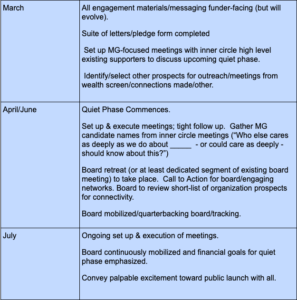
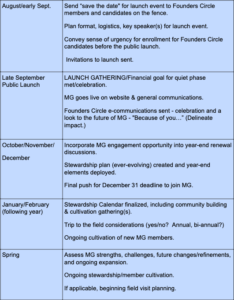
4) How to recognize your major donors
Recognition and benefits should be low-cost to the organization and be designed to further connect funders to the work; i.e. newsletter, beneficiary stories from the field, formal recognition opportunities, periodic gatherings, and travel to the field paid for by participants. To some extent, the benefits should map to the giving level of the Major Gifts program; however, this needn’t always be the case if the overall culture of your funder base is fiercely mission-focused.
Recognition and Benefits examples follow:
- Ultimate “insider access” to organization leadership and general events
- Special Major Gifts-focused events for members in key geographies
- Special recognition in publications (annual report, website, newsletter)
- Personalized contact with beneficiaries (letters/video clips from those helped by non-profit, etc.)
- Insider communications, including from the field
- Access to/thought partnership with ED/Founder
- Unique travel opportunities (annual? Bi-annual?) Members would pay for trip costs, but a trip like this would provide “ultimate insider” access while strengthening funder relationships.
- Creation of branded collateral, such as holiday cards, and/or a feature in the Annual Report and website and social media
- Recognition system for long-term members for key anniversaries.
- Flexible giving options (stock, bitcoin, planned giving, etc.)
- First look at research and reports produced by the organization
- Exclusive group conference calls and webinars with organization leadership
- Serve as ambassadors and advocates to further the mission of the organization
- Be in community with like-minded global citizens
Recommendations for printed collateral
Strong printed collateral is an essential component of an effective program. Here are our top recommendations to ensure success.
- The marketing piece complements the in-person conversation and shouldn’t be over-the-top, as that can be off-putting to many funders who are mindful of overhead expenses. You want to create an exclusive feel but do so elegantly – less is more in this case.
- We recommend using an unusual size to set the Major Gifts program apart from other organization materials – this is a unique invitation. A square conveys quality and class. 9” x 9” folded or tri-fold (meaning what the cover is 9” x 9” not folded down to a smaller size), depending upon the number of images.
- Paper stock matters. You’ll want a thick, high-end feel for this high-end group. 100# dull matte cover stock, or 120# for example.
- The images for the piece should be an invitation to connection – on some level we’d like for candidates to see themselves reflected in the piece.
- The text should be easy to read and play off of the images. Do you have a set font you always use? Be consistent.
- An expanded “Case for Support” can be created in telling the overarching story of the organization within the Major Gifts program. This wouldn’t be a printed piece but more of a pitch deck format that can be used as a framework for an in-person narrative/ask, but also can be emailed.
5) Spotlight on securing multi-year unrestricted major gifts
Prepared by Julie Cullings, Business Manager, Black Fox Philanthropy, B Corp
For the final section of this resource, we’ll focus on a rare but important type of funding: multi-year unrestricted gifts. Securing multi-year unrestricted major gifts should be high on the list of your Major Gifts program’s key objectives. Although this type of funding can be challenging to come by, it provides a high level of flexibility and security for your organization, despite the steep competition.
Unrestricted funding allows organizations to grow in whatever capacity is most needed, including improving their infrastructure, supporting operations, or simply allowing the organization to be nimble to respond in times of crisis or a quickly changing philanthropic landscape, like what we are currently seeing during the COVID-19 crisis.
Multi-year funding also allows organizations to make tangible, long-term plans. Organizations can feel comfortable to see their projects through to completion. Instead of worrying about where their next wave of funding is coming from, they can be wholly focused on maximizing impact.
When funding is both multi-year and unrestricted, the impact on your organization’s capacity is exponential. Furthermore, securing a multi-year unrestricted gift from a major donor is even more appealing. A recent study from the Center for Effective Philanthropy found that two-thirds of nonprofit leaders would prefer to receive more funding from major donors versus foundations, which tends to require less reporting and frees up more staff time. Additionally Foundation grant priorities can change, whereas individual donors are likely to remain passionate about the same causes and interests over a long period of time.
However, multi-year unrestricted funding can be hard to come by from both foundation funders and individual donors, which is why our focus for this section is helping you explore unique approaches to securing these rare gifts.
Approaches to securing multi-year unrestricted gifts
Beyond the tried and true approaches of persistence and forging strong relationships with foundation and individual donors, which we go in-depth on in our Leading the Donor Dance and Strengthening Funder Relationships resources, what other approaches can your organization utilize to secure multi-year unrestricted funding?
Establish Clear and Responsive Communications with Individual Donors
Part of the reason why securing multi-year unrestricted funding is so difficult, especially among individual donors, is because some do not fully realize why this type of support is needed. Individual major donors need to better understand the work that your organization does, including all of your complexities and challenges. Instead of data-driven impact reports, storytelling with passion and authenticity should be at the heart of your communications with donors. Casting your donor as the hero of that story and finding how you share the same vision will facilitate deep and sustainable alliances with donors. When a donor sees and resonates with your organization’s long-term goals, they are more likely to commit to longer-term gifts, as well as trust you with those funds to deliver. Retaining that trust through strong, responsive communication (including discovering their communication method of choice and sticking to it) and transparency will be key to securing repeat gifts.
Retain Talented Major Gift Officers
We know that relationships are at the core of what connects donors to nonprofits, and the major gift officer is often the face of that relationship. Officers who can appreciate and understand the organization’s mission and the donor’s interests, listen and ask the right questions, respect the timing and patience involved in the asking process, and lead with a heart-centered focus are valuable, especially in terms of securing multi-year, unrestricted funding. This value increases when an officer stays in a role for three to six years.
However, retaining top talent is easier said than done! With development professionals often changing jobs every 1-2 years, competition can become fierce. Not only is the relationship with the donor and gift officer incredibly important, but departures from your organization may send damaging signals to donors. To prioritize retaining top major gift officers, Ronald Schiller, Founding Partner of the Aspen Leadership Group and the Philanthropy Career Network, recommends that organizations view talent retention in the same vein as the organization views donor cultivation. To do this, Schiller recommends nonprofit leaders add a regular agenda item to discuss “top performers and rising stars” in senior development leadership meetings to keep retention at the forefront.
Explore and Seek Funding from Giving Circles
Another alternative to seeking individual major gifts and foundation funding, and perhaps a happy medium to those options, is giving circles. A giving circle is a group of individuals who each donate a specific amount of money. The total collection of funds is then distributed to an organization or cause that is decided upon collectively by the group members.
Giving circles often offer grant opportunities that do not exist in the realm of foundation funders. This is especially important for nonprofits with a specific or unique focus that may be precluded from mainstream grant opportunities. Perhaps most importantly, larger giving circles make more strategic gifts, including multi-year and operational expense funding.
So how can your organization engage giving circles? Many giving circles can be found on Google, but also be sure to check with Board members or existing donors to see if they belong to or have connections with any circles that might be a good fit. Once the giving circle is selected, nonprofits must make an ask, whether it be a formal application or a less formal inquiry depending on the requirements of the specific circle.
Though obtaining multi-year, unrestricted funding is no doubt a challenging endeavor, nonprofit organizations can take comfort in knowing there are additional steps they can take to increase their chances of securing these rare gifts.
We wish you great success in your pursuit of major gifts funders who help bolster the delivery of your vital mission. For more insights, we also love this Major Gifts Guide from Salsa Labs.




